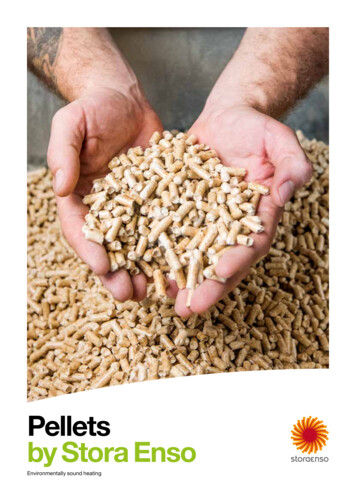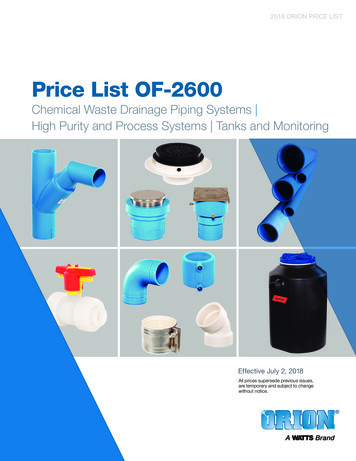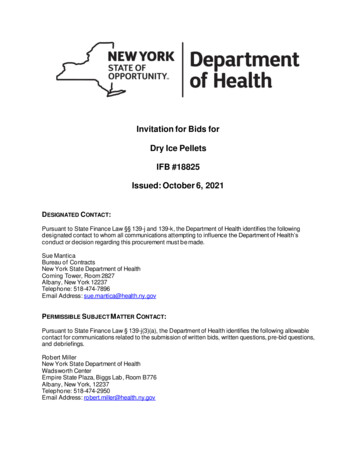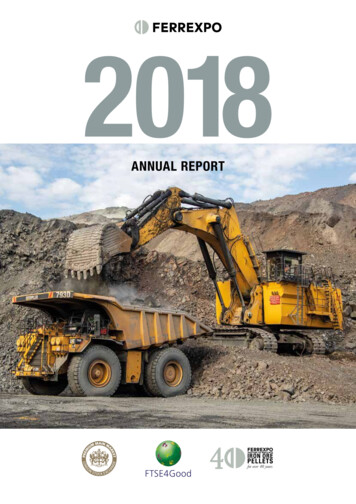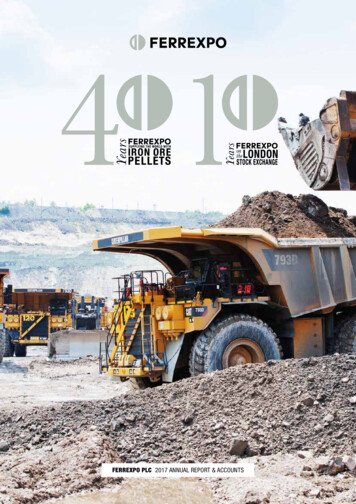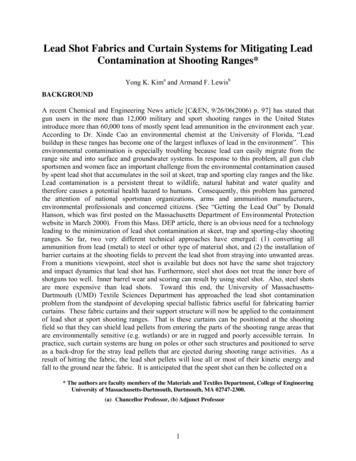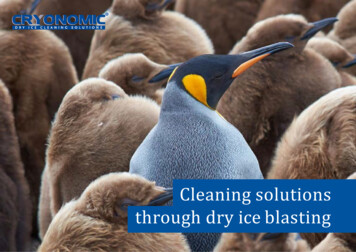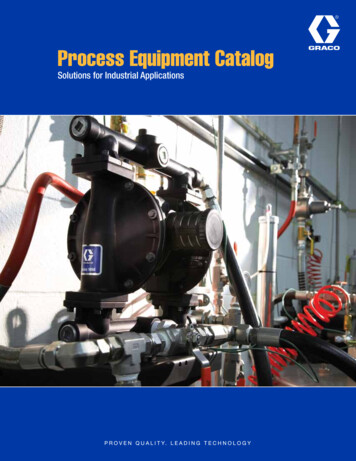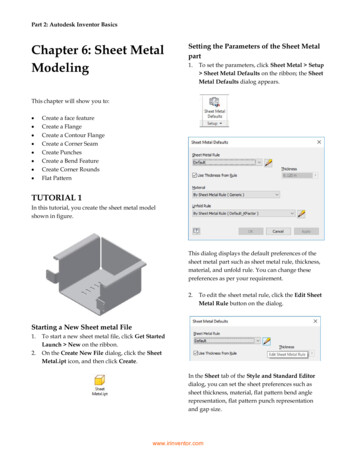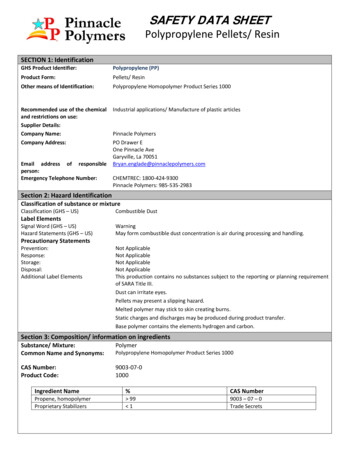
Transcription
SAFETY DATA SHEETPolypropylene Pellets/ ResinSECTION 1: IdentificationGHS Product Identifier:Polypropylene (PP)Product Form:Pellets/ ResinOther means of Identification:Polypropylene Homopolymer Product Series 1000Recommended use of the chemicaland restrictions on use:Supplier Details:Company Name:Industrial applications/ Manufacture of plastic articlesCompany Address:Email address of responsibleperson:Emergency Telephone Number:Pinnacle PolymersPO Drawer EOne Pinnacle AveGaryville, La 70051Bryan.englade@pinnaclepolymers.comCHEMTREC: 1800‐424‐9300Pinnacle Polymers: 985‐535‐2983Section 2: Hazard IdentificationClassification of substance or mixtureClassification (GHS – US)Combustible DustLabel ElementsSignal Word (GHS – US)Hazard Statements (GHS – US)WarningMay form combustible dust concentration is air during processing and handling.Precautionary itional Label ElementsNot ApplicableNot ApplicableNot ApplicableNot ApplicableThis production contains no substances subject to the reporting or planning requirementof SARA Title III.Dust can irritate eyes.Pellets may present a slipping hazard.Melted polymer may stick to skin creating burns.Static charges and discharges may be produced during product transfer.Base polymer contains the elements hydrogen and carbon.Section 3: Composition/ information on ingredientsSubstance/ Mixture:Common Name and Synonyms:Polypropylene Homopolymer Product Series 1000PolymerCAS Number:Product Code:9003‐07‐01000Ingredient Name%CAS NumberPropene, homopolymerProprietary Stabilizers 99 19003 – 07 – 0Trade Secrets
Polypropylene Resin/PelletsSection 4: First Aid MeasuresDescription of necessary first aid measuresInhalation:Skin Contact:Eye Contact:Ingestion:If there is excessive inhalation of fumes move person to fresh air. Get medical attention if symptoms continue.If material is molten, do not pull molten polymer from skin. Cool with water. Get medical attention if burn issevere.If material is molten cool with water and get medical attention. If material is dust rinse with water and getmedical attention if symptoms persist.Remove material from mouth. Rinse mouth with water.Most important symptoms and effects, both acute and delayedInhalation:Skin Contact:Eye Contact:Ingestion:Nuisance dusts can be irritating to the upper respiratory tract. Irritating fume may form when the material isheated.Contact with hot or molten material may cause thermal burns to the skin.Dust from processing may cause irritation to the eyes. Contact to the eyes with molten material may causethermal burns.Swallowed material should pose no hazard, but get medical attention if symptoms occur. May be a chokinghazard.Indication of any immediate medical attention and special treatment neededNo further information available.Section 5: Firefighting MeasuresExtinguishing mediaSuitable extinguishing media:Unsuitable extinguishing media:Dry chemical extinguisher, carbon dioxide extinguisher, water spray/ mistDo not use solid stream or jet. May cause fire to spread.Special hazards arising from the chemicalFire hazard:Explosion hazard:Hazardous decomposition productsin case of fire:May be combustible at high temperatures. May form combustible dust concentration inair.Dust explosion hazard. Airborne dust that is exposed to an ignition source may burn inopen areas or explode in confined spaces.Release of carbon dioxide, carbon monoxide, and hydrocarbons.Advice for firefightersFirefighting instructions:Protection during firefighting:Other information:Remove all nonessential personnel from area. Do no use high pressure stream/ jet toextinguish fire. Be careful not to raise flammable dust during firefighting measures.Self – contained breathing apparatus and protective firefighting clothing (bunker gear)should be worn if fighting the fire at a close proximity.Hot material may reignite, keep material wet until cooled.Section 6: Accidental Release MeasuresPersonal precautions, protective equipment and emergency proceduresFor non – emergency personnel:For emergency responders:Environmental precaution:Spilled material may create a slipping hazard. Remove material from walking/ workingsurfaces immediately.Protective clothing may be necessary in certain incidents – see Section 8 for furtherinformationRecycle if possible. Do not dispose of this material into the environment. Do not allowmaterial to enter public waterways.Methods and materials for containment and clean upSmall Spill:Large Spill:Date of Issue: July 2015Vacuum, sweep and shovel material into suitable containers. Recycle or dispose of inaccordance with local, state and federal laws.Prevent spread of material. Vacuum, sweep and shovel material into suitable containers.Recycle or dispose of in accordance with local, state and federal laws. Inform localauthorizes of any spread into sewage or open bodies of water. Avoid creating large amountsof dust in confined areas.Revision: 0
Polypropylene Resin/PelletsSection 7: Handling and StoragePrecautions for safe handlingProtective Measures:Hygiene Measures:Conditions for safe storage,including any incompatibilitiesMaintain good housekeeping. Avoid spills and potential slipping hazards caused by pellets.Employees may be exposed to engulfment hazards when handling bulk materials. Do notstore material near flammable substances. Provide adequate ventilation and dust controlmeasures. Ground and bond transfer equipment and storage containers to dissipate staticcharges.Do not breathe gas, fumes, or vapors from this product. Wear protective clothing whenhandling hot or molten material.Do not eat, drink or smoke while handling material. Wash hands and face after handlingmaterial.Avoid storing material near flammable materials. Keep away from strong oxide agents.Store in clean dry areas away from direct sunlight. Ground/ bond containers and transferequipment.Section 8: Exposure controls/personal protectionOccupational exposure limitsIngredient NamePolypropylene (PP) Resin/ PelletsExposure LimitsACGIH TLV (United States).Particulates Not Otherwise SpecifiedTWA: 10 mg/m³ 8 hours. Form: InhalableParticulates Not Otherwise SpecifiedTWA: 3 mg/m³ 8 hours. Form: Respirable fractionOSHA PEL (United States).Particulates Not Otherwise SpecifiedTWA: 5 mg/m³ 8 hours. Form: Respirable fractionParticulates Not Otherwise SpecifiedTWA: 15 mg/m³ 8 hours. Form: TotalExposure ControlsAppropriate engineering controlsEnvironmental exposure controlsIndividual protection measuresHand protectionEye/ face protectionSkin and body protectionRespiratory ProtectionWork area should have adequate ventilation. If dust generation occurs during processing,local ventilation should be provided to prevent exposure.Ventilation of dust must comply with local, state and federal regulation.Use proper hand protection when handling hot or molten material to prevent thermalburns.Safety glasses. Face shield may be need when handling hot or molten material to preventthermal burns.Wear proper protective clothing.Respiratory protection may be needed when handling material in areas that do not haveadequate ventilation, or if vapors or fumes are present.Section 9: Physical and Chemical PropertiesInformation on basic physical and chemical propertiesPhysical StateAppearanceColorOdorOdor ThresholdpHMelting PointBoiling PointFlash PointEvaporation RateFlammability (solid, gas)Lower and up flammability or explosive limitSolidPellets/ResinTranslucent, opaque, or whiteOdorlessNo data availableNo data available165 CNo data availableNo data availableNo data availableNo data availableNo data availableDate of Issue: July 2015Revision: 0
Polypropylene Resin/PelletsVapor pressureVapor densityRelative densitySolubilityPartition coefficient: n‐octanol/waterAuto ignition temperatureDecomposition temperaturePossibility of hazardous reactionsConditions to AvoidIncompatible materialsHazardous decomposition productsNo data availableNo data availableNo data availableInsoluble in waterInsoluble in water and octanol 340 C 300 CNo data availableStrong Oxidizing agentsStrong Oxidizing agentsNo data availableSection 10: Stability and ReactivityReactivityChemical stabilityPossibility of hazardous reactionsNo data available related to reactivity for this product or its ingredientsThe product is stableHazardous reactions will not occur under normal operating and storage conditions.Dust may form explosive mixture in air.Avoid dust formation/accumulation. Dust can cause eye irritation and explosivemixture in air. Avoid buildup of static charges. Heat, open flames, sparks and directsunlight. Vapors or fumes can cause respiratory tract irritation.Strong Oxidizing agentsHazardous decomposition products formed under fire conditions: carbon monoxide,carbon dioxide, toxic fumes.Conditions to AvoidIncompatible materialsHazardous decomposition productsSection 11:Toxicological InformationInformation on the likely routesof exposureOral, Dermal, InhalationAcute ToxicityNot classifiedSkin or eye absorptionExposure to dusts may cause eye irritationInhalationExposure to dusts, fumes or vapors may cause respiratory tract irritation.IngestionNo known effects or hazardsCarcinogenicityNot classifiable as to its carcinogenicity to humansReproductive toxicityNot classifiedSpecific target organ toxicity Not classified(single/repeat)Aspiration hazardNot classifiedSection 12: Ecological InformationEcotoxicityPersistence and degradabilityBioaccumulative potentialMobility in soilOther adverse effectsWildlife, especially small fish may digest pellets. Pellets are not toxic, but may block thedigestive tract and cause starvation or death.Biologically non‐degradable. Degrades under long term exposure to sunlight and/or heatNot known to be bio‐accumulativeLow mobilityNo known significant effects or hazardsSection 13: Disposal considerationsDisposal MethodsThis product does not meet the RCRA criteria of a hazardous waste. Product can berecycled. Disposal should only be considered if no further recycling is possible. Dispose inaccordance with local, state, and federal regulations.Section 14: Transport informationUN NumberNot regulatedUN Proper shipping nameNot regulatedTransport Hazard class(es)Not regulatedPacking group, if applicableNot regulatedMarine pollutant (Yes/No)Date of Issue: July 2015NoRevision: 0
Polypropylene Resin/PelletsSpecial precautions which a user needs to be aware ofor needs to comply with in connection with transportor conveyance either within or outside their premisesNoSection 15: Regulatory InformationU.S. Federal RegulationsTSCASARA 302/304SARA 311/312SARA 313California Proposition 65CanadaAll components of this product are listed or exempted from the United StatesEnvironmental Protection Agency Toxic Substances Control Act inventory.No products were foundFire HazardThis product contains no exceedance of chemical concentration that are subject to thereporting requirements of section 313 of Title III of the Superfund Amendments andReauthorization Act of 1986 and 40 CFR Part 372.This product complies with California Proposition 65All components of this product are listed or exempted from DSL (Domestic SubstancesList)Not Known to contain substances of very high concern (SVHC). ROHS Compliant.EuropeSection 16: Other InformationHazardous Materials Information System This information is intended solely for the use of individuals trained(U.S.A.)in the HMIS system.HMIS III RatingHealth: 0Flammability: 1Physical Hazard: 0Personal Protection : See section 8 of SDSNational Fire Protection Association (NFPA) This information is intended solely for the use of individuals trainedRatingsin the NFPA system.NFPA (National Fire Protection Association)NFPA health hazard:0NFPA fire hazard:1NFPA reactivity:0Date of Issue: July 2015Revision: 0
Polypropylene Resin/PelletsUS OSHA LABEL as specified under 29 CFR §1910.1200 (f)Polypropylene HomopolymerPinnacle Polymers, LLC PO Drawer E Garyville, LA70051 USA Tel. 985-535-2000 or 985-535-1016WarningIf small particles are generated during further processing, handling or by other means, may form combustible dust concentrations inair.Supplemental Information: Based on conditions common to industrial workplace use of this productDo not store near flammable substances. Bond/ ground transfer equipment to prevent static buildup. Spilled pellets may create a slipping hazard.Sweep up spillage and dispose of properly. Skin or eye contact with hot polymer can cause thermal burns. Processing the polymer at hightemperatures may form vapors that irritate the eyes and respiratory tract.The information contained herein is accurate to the best of our knowledge. Pinnacle Polymers makes no warranty of any kind,express or implied, concerning the safe use of this material in your process or in combination with other substances.Date of Issue: July 2015Revision: 0
Pinnacle Polymers, LLC PO Drawer E Garyville, LA 70051 USA Tel. 985-535-2000 or 985-535-1016 Warning If small particles are generated during further processing, handling or by other means, may form combustible dust concentrations in air. Supplemental Information: Based on conditions common to industrial workplace use of this product
